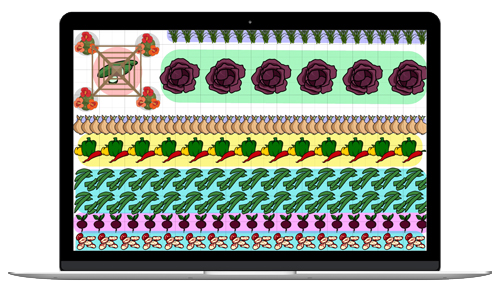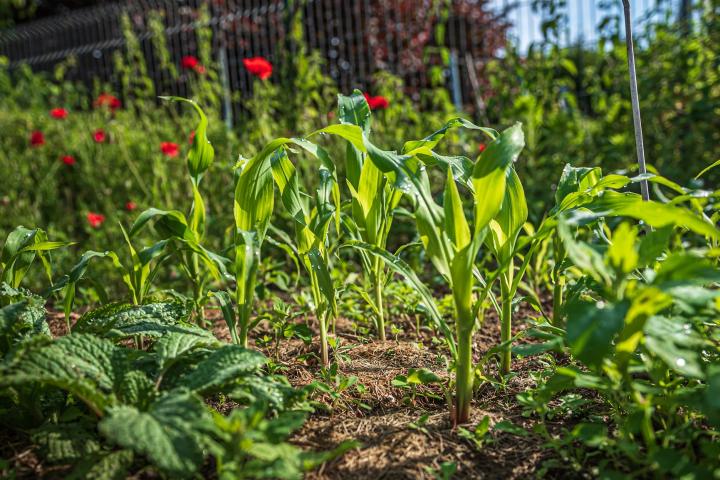
Planting, Growing, and Harvesting Sweet Corn
The Almanac Garden Planner - Use It Free for 7 Days!
Plan your 2025 garden with our award-winning Garden Planner.
Types of Sweet Corn
There are four main types of hybrid sweet corn: sugary (su), sugar-enhanced (se), shrunken (sh, sh2), and synergistic (sy). Each one contains a different level of sucrose, changing the flavor and texture of the corn.The type of corn will be listed right on the seed packet.
It’s important to be aware of which type of corn you’re growing—not only because of the sugar content, but also due to how easily the types can cross-pollinate. If the wrong combination of types cross-pollinates, the ears that are produced may be of subpar quality.
- Sugary (su) sweet corn is the classic sweet corn. Sugary varieties grow vigorously and are stress resistant. The kernels aren’t too sweet and are said to have a “traditional” taste. However, the sugars in sugary sweet corn quickly turn to starch after the ears are picked, so they need to be eaten right after picking. Do not plant near shrunken or synergistic types.
- Sugar-enhanced (se) sweet corn is slightly sweeter than sugary varieties. They keep their sweetness for a longer period of time after harvest (a few days) than sugary varieties. They grow well with few issues. Do not plant near shrunken types.
- Shrunken (sh, sh2) sweet corn—also called “supersweet”—are the sweetest varieties, containing two to three times more sugar than sugary varieties. The sugar in their kernels lasts even longer after harvest (up to a week) than the other types, but kernels tend to be more crunchy and not taste as “corny.” Shrunken types are also more finicky overall. Do not plant them near any other types; hybrid kernels turn out starchy and tough.
- Synergistic (sy) sweet corn combines sugar-enhanced with one of the other two types to create varieties that have the best of both worlds. Synergistic types tend to have very sweet, tender kernels with a good taste and some synergistic varieties can keep up to a week after harvest. Do not plant near sugary or shrunken types.
Recommended varieties include:
- ‘Argent’: sugar-enhanced variety, good taste. White kernels.
- ‘Iochief’: midseason, normal-sugar variety. Yellow kernels.
- ‘Luther Hill’: dwarf, normal-sugar variety. Produces 4- to 6-inch ears on 4- to 5-foot stalks. White kernels. Grow at least nine dwarf plants in a block of three or four rows.
- ‘Silver Queen’: normal-sugar variety. Resistant to some bacterial diseases. White kernels.
- ‘Sweet Sunshine’: supersweet variety. Disease resistant and high yield. Yellow kernels.
Corn can be a feast for the eyes, too! Look for these ornamental varieties:
- ‘Glass Gem’: Sporting multi-colored, semi-transparent kernels, this is a favorite for kids.
- ‘Painted Mountain’: Looking for the classic “maize” colors? This variety has a great diversity of natural tones. Check out our video to learn more about growing and using painted mountain corn.

Cooking Notes
- If too much hot pepper or spice has been added to a soup or stew, adding a can of sweet corn can help.
- Popcorn is also a favorite snack if you have leftover kernels. Learn how to make homemade popcorn here.
ADVERTISEMENT
In a healthy crop, removing the suckers, also called tillers, makes little difference to the harvest yield or health of the plant, since they usually appear later in the season and can’t compete with the main stalk. Their formation may indicate healthy conditions; some varieties tend to form suckers more often. If the crop had been damaged early in the season, or the plants are widely spaced, a corn plant may respond by growing suckers; in these cases, sometimes those suckers will produce harvestable ears. Otherwise, in a healthy, closely spaced crop, they won’t usually.
If you’d like to remove suckers, only do so when they are very small, to prevent damage to the stalk; removing them when they are larger will weaken the plant and invite insects and diseases.
I am using this website as a reference and I cannot seem to find the date this article was published and the authors name.
The author is The Old Farmer’s Almanac. Web pages are updated continuously so there is not a publish date, per se. Look up APA guidelines for how to reference a web article.
Planting Corn. I'm doing a school assignment on corn and was just wondering if anyone could tell me the germination time?
Thanks, Very Much Appreciated,
Chyenne
Germination depends on your soil temperatures and weather conditions. If the teperatures are 60 degrees F or warm, germination may take 10 to 12 days. If the temp is 50 to 55, it may take 3 weeks.
If temps are in the 80-90 then it can be down to 60 to 72 hours.
I wanted to know if i had the right soil prepared and the weather was on my side. Is it possible to grow corn around the middle of August toward the end to yield a good crop.
For a fall harvest, it is recommended corn be planted mid- to late July, August 1st at the latest.
I have this opportunity to use a plot of land in an open field, am planning on planting corn/maize on the land.
Is it preferrable I do in June,
also what can I plant along with it?
can cassava go for it,
Can vegetables do, if so what kind,
Pls I need something that won't cost me a lot... Thanks
The "Three Sisters" is an ideal companion planting: In a hill put a few corn in the middle, pole beans in a ring around that and squash or pumpkin around the outer perimeter of the hill. Each type give the others the nutrients they need to grow well.There's quite a bit about the traditional "Three Sisters" method online. Cassava is a companion to sweet potato according to one companion planting chart I found.












